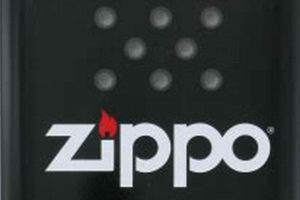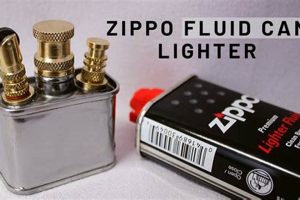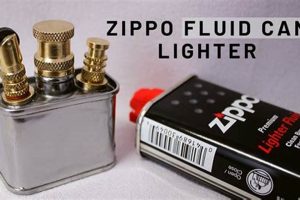Lighter fluid, often used in reusable pocket lighters, is sometimes employed as a fire starter for charcoal grills. This practice, though seemingly convenient, carries significant risks. Lighter fluid is a highly volatile and flammable petroleum distillate, formulated for small-scale ignition, not for saturating large quantities of combustible material. Its improper use can lead to unpredictable flames, dangerous flare-ups, and imparts a petroleum taste to food.
While effective for quickly igniting a lighter’s wick, using this type of fluid to start a charcoal fire can be hazardous. Control over the initial flame is limited, and the rapid vaporization can create a substantial fireball. Furthermore, the chemical composition of lighter fluid is not food-safe. Residual chemicals can taint the flavor of grilled food, introducing undesirable tastes and potentially harmful substances. Safer and more appropriate methods for lighting charcoal, such as chimney starters and electric starters, offer more control and avoid these risks. These methods utilize kindling or heat to ignite the charcoal gradually, promoting even burning and minimizing the risk of flare-ups.
Understanding the dangers associated with using lighter fluid for anything beyond its intended purpose is crucial for safe grilling practices. This discussion will further explore the risks, compare alternative methods, and offer guidance on how to start a charcoal grill safely and effectively.
Safe Charcoal Lighting Tips
Employing proper fire starting techniques is crucial for safe and enjoyable grilling. These guidelines offer safer alternatives to using highly flammable lighter fluids for igniting charcoal.
Tip 1: Utilize a Chimney Starter: Chimney starters offer a controlled and efficient method. Fill the chimney with charcoal, place crumpled newspaper beneath, and ignite the paper. The rising heat quickly ignites the charcoal, producing evenly burning embers within 20 minutes.
Tip 2: Opt for Electric Charcoal Starters: Electric starters provide a flameless method, eliminating the need for any flammable liquids. Simply insert the starter into the charcoal pile and plug it in. The heating element quickly ignites the surrounding charcoal.
Tip 3: Consider Charcoal Briquettes Designed for Easy Lighting: Certain briquettes incorporate additives that promote faster ignition with a match or lighter, offering a safer alternative to pouring flammable liquids onto charcoal.
Tip 4: Exercise Proper Lighter Fluid Handling (if unavoidable): If lighter fluid must be used, follow these safety precautions: Apply a small amount to the charcoal before lighting, never add fluid to already burning coals, and keep a safe distance while igniting. Store lighter fluid securely away from heat sources and children.
Tip 5: Never Use Gasoline or Other Non-Designated Accelerants: These substances are extremely volatile and dangerous, creating unpredictable and uncontrollable flames. Their use poses a severe fire hazard and should be avoided entirely.
Tip 6: Monitor the Grill Constantly: Never leave a lit grill unattended. Maintain a watchful eye to ensure safe and controlled burning and to address any flare-ups promptly.
Tip 7: Ensure Proper Ventilation: Adequate airflow is essential for safe combustion. Avoid using charcoal grills indoors or in enclosed spaces, as toxic fumes can accumulate.
By adhering to these safety measures, grilling experiences can remain enjoyable and free of hazardous incidents.
Following these tips contributes significantly to minimizing fire risks and ensuring a safe grilling environment. The next section will offer final recommendations for ensuring grilling safety and maximizing enjoyment.
1. Flammability
Flammability, the ease with which a substance ignites and burns, is a critical consideration when using lighter fluid, often associated with Zippo lighters, to start a barbecue. This fluid’s high flammability, while useful for small-scale ignition, presents significant hazards when applied to larger quantities of charcoal.
- Flash Point
The flash point, the lowest temperature at which a liquid releases sufficient vapor to ignite in air near the surface, is extremely low for lighter fluid. This means it can ignite easily even at room temperature with a minimal ignition source, creating a risk of unexpected fires.
- Volatility
Lighter fluid’s high volatility, its tendency to vaporize rapidly, contributes to its flammability. This rapid vaporization creates a large, flammable vapor cloud, increasing the risk of large flames and flare-ups when ignited, posing a danger to those nearby.
- Explosive Limits
The explosive limits, the range of fuel vapor concentrations in air that can ignite, are broad for lighter fluid. This means ignition can occur under a wide range of conditions, increasing the likelihood of accidental ignition and uncontrolled fires.
- Rate of Combustion
The rapid rate at which lighter fluid burns contributes to the intensity of the initial flame. While intended for small-scale ignition, this rapid combustion can become dangerous when used on a larger scale, such as with charcoal barbecues, leading to unpredictable and potentially hazardous flames.
The combination of a low flash point, high volatility, broad explosive limits, and rapid combustion rate makes using lighter fluid on barbecues particularly hazardous. Safer alternatives for lighting charcoal, such as chimney starters or electric starters, minimize these risks while promoting more controlled and efficient ignition.
2. Safety risks
Utilizing lighter fluid, often associated with products like Zippo lighters, for igniting barbecues presents several safety risks stemming from the fluid’s volatile nature and improper handling potential. Understanding these risks is crucial for preventing accidents and ensuring safe grilling practices.
- Uncontrolled Flames
The rapid vaporization and high flammability of lighter fluid can lead to unpredictable and large flames, potentially causing burns or igniting nearby flammable materials. Pouring fluid onto already lit coals intensifies this risk, creating dangerous flare-ups.
- Fuel Spillage
Accidental spillage of lighter fluid, especially near an open flame, poses a severe fire hazard. The fluid can quickly ignite and spread fire to surrounding areas, including clothing or vegetation, resulting in significant damage or injury.
- Improper Storage
Storing lighter fluid incorrectly, such as near heat sources or in unventilated areas, increases the risk of vapor buildup and potential explosions. Exposure to sunlight can also cause pressure buildup in the container, increasing the risk of leaks or bursts.
- Inhalation Hazards
Inhaling lighter fluid fumes, which contain volatile organic compounds, can irritate the respiratory system and cause dizziness or nausea. Concentrated exposure can lead to more severe health problems.
These safety risks underscore the importance of utilizing safer alternatives for lighting charcoal barbecues. Chimney starters, electric starters, and specialized briquettes offer controlled ignition, minimizing the hazards associated with lighter fluid while ensuring a safer and more enjoyable grilling experience. Neglecting these safety precautions can result in severe accidents and injuries, emphasizing the need for responsible handling and adherence to safe grilling practices.
3. Food contamination
Food contamination is a significant concern when using lighter fluid, commonly associated with Zippo lighters, to start charcoal barbecues. The chemical composition of lighter fluid poses risks to food safety and palatability, potentially leading to undesirable health consequences and unpleasant culinary experiences. Understanding these risks is paramount for safe and enjoyable grilling.
- Chemical Residues
Lighter fluid contains volatile organic compounds (VOCs) that can vaporize and condense on food. These residues can impart a distinct petroleum-like taste, significantly affecting the flavor profile of grilled items. Ingestion of these chemicals, even in small amounts, may pose health risks.
- Incomplete Combustion Byproducts
Incomplete combustion of lighter fluid can produce harmful byproducts, including polycyclic aromatic hydrocarbons (PAHs), which can deposit on food. PAHs are known carcinogens and pose significant health risks upon consumption. Ensuring complete combustion of charcoal before cooking is crucial for mitigating this risk, but the use of lighter fluid often hinders this process.
- Absorption into Food
Porous foods, such as meat and vegetables, can absorb lighter fluid and its byproducts. This absorption can lead to the ingestion of harmful chemicals, even if the food appears cooked thoroughly. The risk is particularly high with foods that require longer cooking times, allowing for greater absorption.
- Health Implications
Consuming food contaminated with lighter fluid residues or byproducts can cause various health issues, ranging from mild gastrointestinal discomfort to more serious long-term health problems associated with exposure to VOCs and PAHs. Children and individuals with pre-existing health conditions are particularly vulnerable.
The potential for food contamination underscores the importance of avoiding lighter fluid when starting charcoal barbecues. Safer alternatives, such as chimney starters and electric starters, eliminate this risk, ensuring both the safety and flavor integrity of grilled food. Prioritizing food safety enhances the overall grilling experience, contributing to both enjoyment and well-being.
4. Inefficient combustion
Inefficient combustion is a significant drawback associated with using lighter fluid, often connected with brands like Zippo, for igniting charcoal barbecues. This inefficiency stems from the rapid and uncontrolled burning of the fluid itself, which often fails to effectively transfer heat to the charcoal for sustained ignition. The process typically involves a large initial flame consuming the readily available lighter fluid, but this intense burn often dissipates quickly without thoroughly igniting the charcoal. This results in a need for repeated applications of lighter fluid, leading to increased fuel consumption, prolonged starting times, and uneven charcoal heating.
The primary cause of this inefficiency lies in the volatility of lighter fluid. Its rapid vaporization creates a large flammable vapor cloud that ignites readily, producing a dramatic but short-lived burst of flame. This rapid combustion consumes the lighter fluid before sufficient heat can transfer to the charcoal briquettes. Consequently, the charcoal may only partially ignite, requiring further applications of lighter fluid and leading to an extended and frustrating starting process. Furthermore, the uneven distribution of heat from the localized flames can create hot spots and cool spots within the charcoal bed, resulting in uneven cooking temperatures. This inconsistency can lead to undercooked or overcooked food, compromising the overall grilling experience.
Understanding the inefficiency of lighter fluid as a charcoal starter underscores the importance of considering alternative methods. Chimney starters, electric starters, or charcoal designed for easier ignition offer more controlled and efficient heating, ensuring even charcoal burning and consistent cooking temperatures. These methods not only minimize fuel consumption and reduce starting times but also contribute to a safer and more environmentally friendly grilling experience. Choosing these alternatives ultimately leads to better cooking results and a more enjoyable barbecue.
5. Safer alternatives
Safer alternatives to using lighter fluid, often associated with Zippo lighters, for igniting charcoal barbecues are essential for mitigating the inherent risks associated with this practice. These alternatives prioritize safety, efficiency, and environmental responsibility, offering superior methods for starting charcoal fires and ensuring a more enjoyable grilling experience. Exploring these alternatives highlights the advantages of moving away from hazardous practices toward safer and more controlled methods.
- Chimney Starters
Chimney starters provide a safe, efficient, and cost-effective method. These metal cylinders contain charcoal and utilize newspaper or kindling for ignition. The chimney’s design promotes airflow, allowing the fire to spread quickly and evenly throughout the charcoal. This concentrated heat ensures rapid and complete ignition without requiring accelerants, minimizing risks and maximizing efficiency.
- Electric Charcoal Starters
Electric starters offer a flameless and convenient method. These devices utilize a heating element to ignite the charcoal, eliminating the need for any flammable materials. Simply place the starter within the charcoal pile, plug it in, and wait for the coals to ignite. Electric starters minimize fire hazards and offer precise control over the ignition process, ensuring consistent and even heating.
- Specific Charcoal Briquettes
Certain charcoal briquettes are formulated for easier ignition, incorporating additives that reduce the need for accelerants. These briquettes often require only a match or lighter for ignition, simplifying the starting process and minimizing risks. This method offers a convenient and relatively safe alternative, particularly for smaller barbecues or quick grilling sessions.
- Natural Fire Starters
Natural fire starters, such as fire starters made from wood shavings and wax, provide an environmentally friendly alternative to chemical accelerants. These starters ignite easily and burn steadily, providing sufficient heat to ignite charcoal without introducing harmful chemicals or producing undesirable flavors. This method aligns with sustainable grilling practices while ensuring safe and efficient ignition.
Adopting these safer alternatives to lighter fluid significantly reduces the risks associated with grilling, promoting a safer and more enjoyable experience. By prioritizing these methods, individuals can minimize the potential for accidents, ensure consistent cooking results, and contribute to environmentally responsible grilling practices. The benefits of these alternatives extend beyond mere convenience, encompassing crucial safety and health considerations that are paramount for responsible outdoor cooking.
Frequently Asked Questions
This FAQ section addresses common concerns and misconceptions regarding the use of lighter fluid, often associated with products like Zippo lighters, for igniting charcoal barbecues. Understanding these points is crucial for promoting safe and responsible grilling practices.
Question 1: Is using lighter fluid to start a charcoal grill safe?
While lighter fluid can ignite charcoal, it presents significant safety risks due to its high flammability and potential for uncontrolled flames. Safer alternatives are strongly recommended.
Question 2: What are the dangers of using lighter fluid on a barbecue?
Dangers include unpredictable flare-ups, potential burns, fire hazards from spills, and the risk of food contamination from chemical residues.
Question 3: Can lighter fluid affect the taste of food?
Yes, lighter fluid can impart a noticeable chemical taste to food, negatively impacting the flavor. Chemical residues from incomplete combustion can also contaminate food.
Question 4: What are some safer alternatives to lighter fluid for starting a charcoal grill?
Chimney starters, electric charcoal starters, and specially designed briquettes offer safer and more controlled ignition methods.
Question 5: How can one minimize risks when using lighter fluid, if absolutely necessary?
If lighter fluid must be used, apply a small amount to unlit charcoal, never add it to burning coals, and keep a safe distance while igniting. Ensure proper storage away from heat sources and children.
Question 6: Why is it important to avoid using gasoline or other accelerants on a charcoal grill?
Gasoline and similar accelerants are extremely volatile and dangerous, producing unpredictable and uncontrollable flames that pose a severe fire hazard.
Prioritizing safety is paramount for enjoyable grilling. Choosing safer alternatives and adhering to proper handling procedures significantly reduces risks and ensures a positive outdoor cooking experience.
For further guidance on safe grilling practices, consult local fire safety guidelines and reputable resources dedicated to outdoor cooking safety.
The Hazards of Lighter Fluid Use in Charcoal Grilling
Examination of the practice of using lighter fluid, often associated with pocket lighters like those made by Zippo, for igniting charcoal barbecues reveals significant safety and culinary concerns. The highly flammable nature of this petroleum distillate creates risks of uncontrolled flames, posing dangers to individuals and property. Furthermore, its chemical composition can contaminate food, introducing undesirable flavors and potential health risks. The inherent inefficiency of lighter fluid as a charcoal starter necessitates repeated applications, leading to increased fuel consumption and uneven heating, ultimately compromising cooking quality.
Safe and enjoyable grilling experiences hinge upon responsible practices. Employing safer alternatives, such as chimney starters, electric starters, or purpose-designed charcoal briquettes, eliminates the hazards associated with lighter fluid while promoting efficient and consistent cooking. Prioritizing these safer methods demonstrates a commitment to responsible grilling, ensuring both personal safety and the enjoyment of flavorful, untainted food. A shift toward these practices is essential for fostering a culture of safety and responsibility in outdoor cooking.







